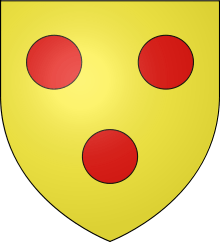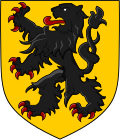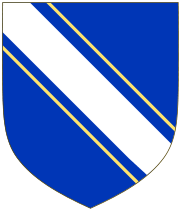County of Boulogne
The County of Boulogne was a county within the Kingdom of France during the 9th to 15th centuries, centred on the city of Boulogne-sur-Mer. It was ruled by the counts of Flandres in the 10th century, but a separate House of Boulogne emerges in the 11th.[1] It was annexed by Philip II of France in 1212 and after this was treated as part of the county of Artois, until it was finally annexed into the royal domain in 1550.
County of Boulogne Comté de Boulogne | |||||||
|---|---|---|---|---|---|---|---|
| 896–1501 | |||||||
 Coat of arms
| |||||||
| Status | Part of the Kingdom of France (1212–1501) | ||||||
| Capital | Boulogne | ||||||
| Historical era | Middle Ages | ||||||
• acquisition by the House of Flanders | 896 | ||||||
• annexed by Philip II of France | 1212 | ||||||
• incorporation into the crown lands of France | 1501 | ||||||
| |||||||
History
Boulogne was already a pagus within the kingdom of the Franks (pagus Bononiensis). There are few records prior to the 11th century. A proverbially wicked count named Herrequin is recorded for the 9th century, but he may be legendary (see Herla, Erlking). It seems to have come under the rule of the counts of Flanders in the late 9th or early 10th century. In 886, bishop Gauzlin of Paris asked count Erkenger of Boulogne to solicit German help against the Viking raids. Erkenger was lost all his possessions in 896, as he remained loyal to Charles the Simple. It may have been at this point that Baldwin II, Count of Flanders gained control over Boulogne.
Eustace II of Boulogne accompanied William the Conqueror's invasion in 1066. Boulogne was also a major participant in the First Crusade; Eustace III of Boulogne's brothers, Godfrey of Bouillon and Baldwin of Bouillon, both became kings of Jerusalem, and Eustace himself was offered but declined the title.
Count Renaud of Boulogne joined the imperial side at the Battle of Bouvines in 1214, and was defeated by Philip II of France.
Boulogne passed under nominal royal control in 1223 when it was given to Philip II's son Philip Hurepel.[2] Hurepel revolted against Blanche of Castile when Louis VIII of France died in 1226. When Philip Hurepel died in 1235, Matilda continued to reign and in 1238 was married to Alphonse, second son of King Alfonso II of Portugal, and younger brother of King Sancho II of Portugal. Having become Afonso III of Portugal in 1248 and renounced his title of Count of Boulogne, Alfonse divorced her in 1253 due to her barrenness in favour of Beatrice of Castile.
Nevertheless, Matilda and Philip did have a son Alberic, and a daughter Joan who both survived. Alberic reportedly renounced his rights and went to England, for unknown reasons. Apparently he survived his mother and died in 1284, but presumably did not leave issue. Joan was married in 1236 to Gaucher de Châtillon, Count of Mortain (d. 1251). She predeceased her mother in 1252, and presumably left no surviving issue.
Consequently, after Matilda, her county of Boulogne then passed to Matilda's niece, Adelaide of Brabant and her husband William X of Auvergne.
Bertrand V de la Tour succeeded to the counties of Auvergne and of Boulogne in 1437. Through his son Bertrand VI de la Tour the County of Boulogne passed to his grandson, the last medieval count of Boulogne: Jean III de la Tour d'Auvergne. By his marriage to Jeanne of Bourbon-Vendôme, he left two daughters:
- The eldest daughter, Anne of la Tour d'Auvergne, married John Stewart, Duke of Albany, however she died childless in 1524.
- The youngest, Madeleine de La Tour d'Auvergne married Lorenzo II de' Medici and gave birth to Catherine de' Medici, who inherited both Auvergne and Boulogne due to the death of the childless Anne.
On the death of Jean III de la Tour d'Auvergne in 1501, Anne inherited the title Countess of Boulogne; however at her death the title passed to Madeleine's daughter Catherine de Medici since Madeleine herself had died in 1519. Catherine became Queen of France in 1549 and the title passed to the French crown.
Boulogne was attacked numerous times during the Hundred Years' War and occupied numerous time by the English: the last time from 1544 to 1550. In 1550 the Peace of Boulogne ended the war between England and France and France bought back Boulogne for 400,000 crowns. (See also the Sieges of Boulogne (1544–46)).
List of counts
- House of Flanders

- 896–918 : Baldwin I (also count of Flanders)
- 918–933 : Adelolf (son of Baldwin I)
- 933–964 : Arnulf I (son of Baldwin I, also count of Flanders)
- 964–971 : Arnulf II (son of Adalolf)
- 971–990 : Arnulf III (son of)
- 990–1025 : Baldwin II (son of)
- House of Boulogne

- 1032–1049 : Eustace I (son of)
- 1049–1087 : Eustace II[3] (son of)
- 1087–1125 : Eustace III[3] (son of)
- 1125–1151 : Matilda I (daughter of, married to Stephen of Blois, also Count of Blois, Count of Mortain, Duke of Normandy and King of England)
- House of Blois

- 1151–1153 : Eustace IV (son of, also Count of Mortain)
- 1153–1159 : William I (brother of, also Count of Mortain and Earl of Surrey)
- 1159–1170 : Mary I (sister of, married Matthew of Alsace)
- House of Alsace

- 1170–1173 : Matthew
- 1173–1216 : Ida (daughter of, married Renaud of Dammartin, Count of Dammartin-en-Goële and Count of Aumale)
- 1173–1180 : Matthew II
- 1181–1182 : Gerard
- 1183–1186 : Berthold
- House of Dammartin

- 1216–1260 : Matilda II (also Countess of Clermont-en-Beauvaisis and Queen of Portugal by her two marriages, Countess of Mortain, Countess of Aumale and Countess of Dammartin-en-Goële, married)
- 1223–1235 : Philip I (also Count of Clermont-en-Beauvaisis)
- 1235–1253 : Afonso (also King of Portugal)
- House of Auvergne

- 1260–1261 : Adelaide (Cousin of, married William III, Count of Auvergne)
- 1261–1277 : Robert I (son of, also Count of Auvergne)
- 1277–1314 : Robert II (son of, also Count of Auvergne)
- 1314–1325 : Robert III (son of, also Count of Auvergne)
- 1325–1332 : William II (son of, also Count of Auvergne)
- 1332–1360 : Joanna I (daughter of, also Countess of Auvergne, married)
- 1338–1346 : Philip II (also Count of Auvergne)
- House of Burgundy

- 1360–1361 : Philip III (son of, also Duke of Burgundy, Count of Auvergne, Count of Artois and Count of Franche-Compté)
- House of Auvergne

- 1361–1386 : John II (son of Robert III, also Count of Auvergne)
- 1386–1404 : John III (son of, also Count of Auvergne)
- 1404–1424 : Joanna II (daughter of, also Countess of Auvergne, married)
- 1404–1416 : John IV (also Duke of Berry)
- 1416–1424 : George
- 1424–1437 : Mary II (cousin of, also Countess of Auvergne)
- House of La Tour d'Auvergne

- 1437–1461 : Bertrand I (son of, also Count of Auvergne)
- 1461–1497 : Bertrand II (son of, also Count of Auvergne)
- 1497–1501 : John V (son of, also Count of Auvergne)
After the death of John V, Count of Boulogne, the County of Boulogne was integrated into the royal domain.
See also
- County of Artois
- County of Flanders
- Siege of Boulogne (disambiguation)
References
- Heather J. Tanner, The Expansion of the Power and Influence of the Counts of Boulogne under Eustace II', Anglo-Norman Studies XIV: Proceedings of the Battle Conference 1991, Ed. Marjorie Chibnall (The Boydell Press, Woodbridge, UK, 1992), p. 251
- "Boulogne-sur-Mer (Municipality, Pas-de-Calais, France)". Flagspot.net. Retrieved 2013-03-27.
- "NORTHERN FRANCE, NOBILITY". Retrieved 4 November 2007.